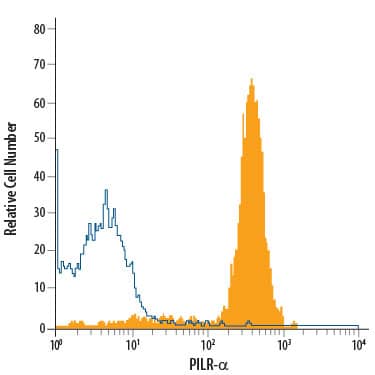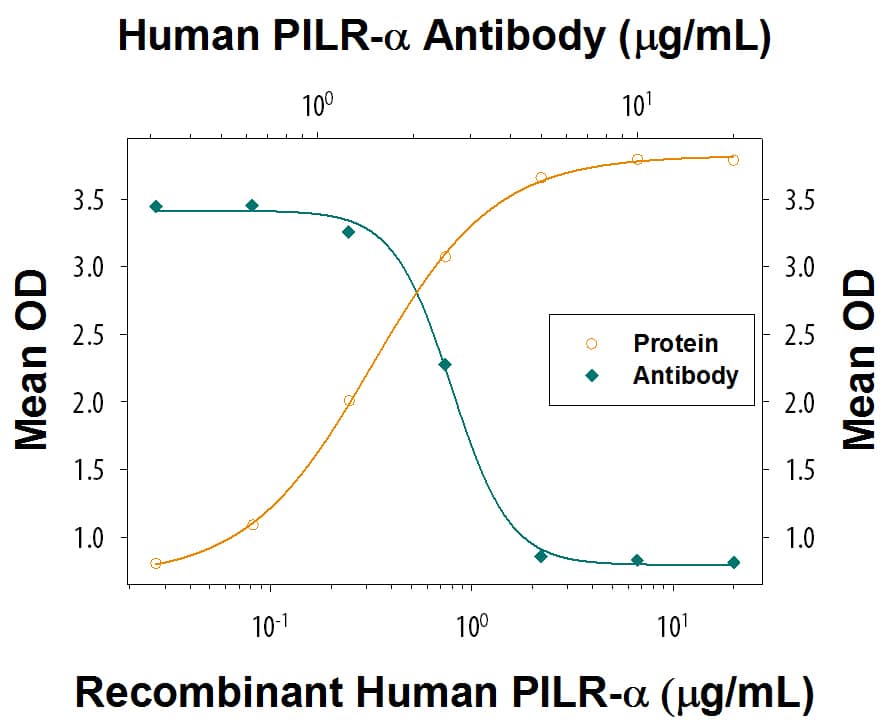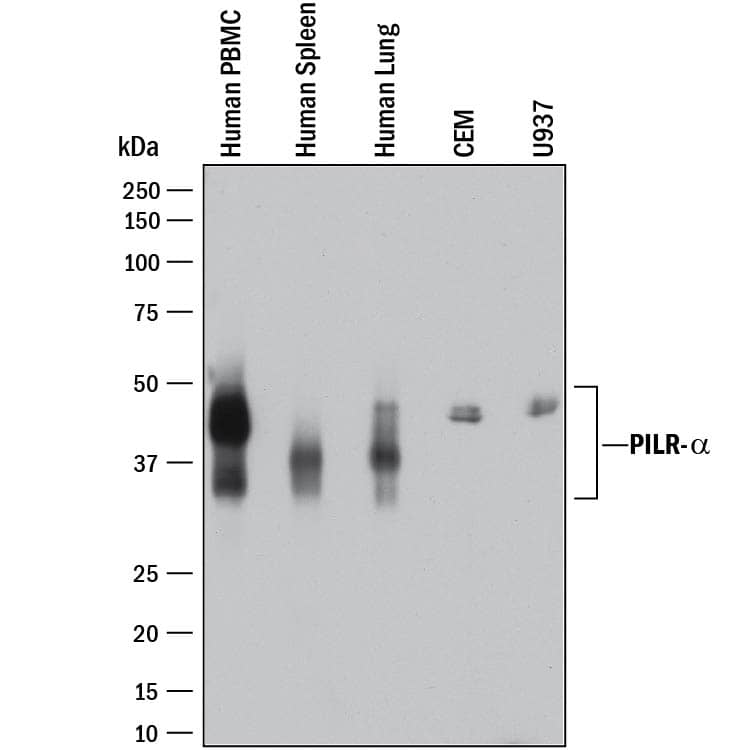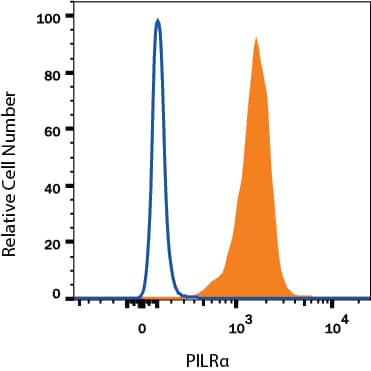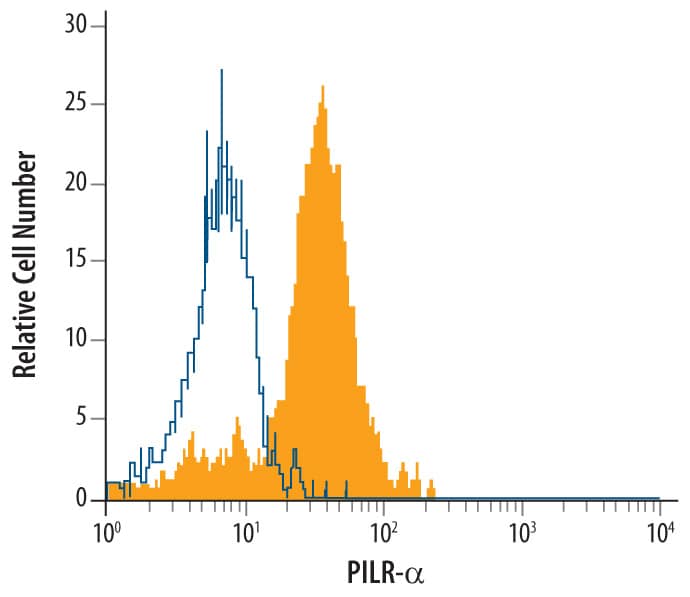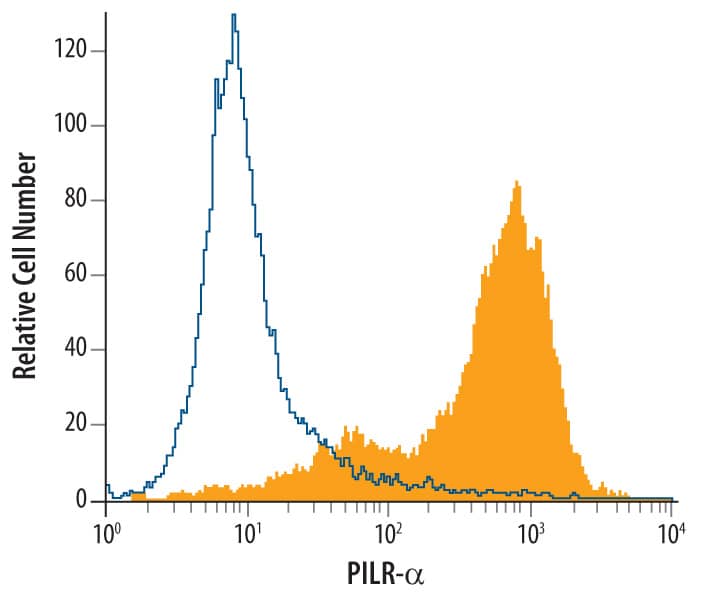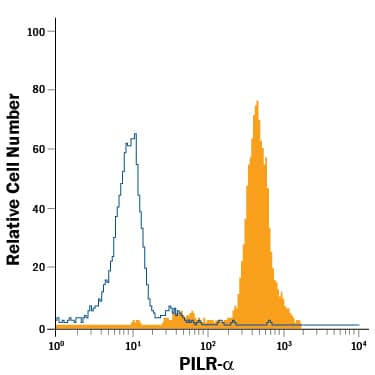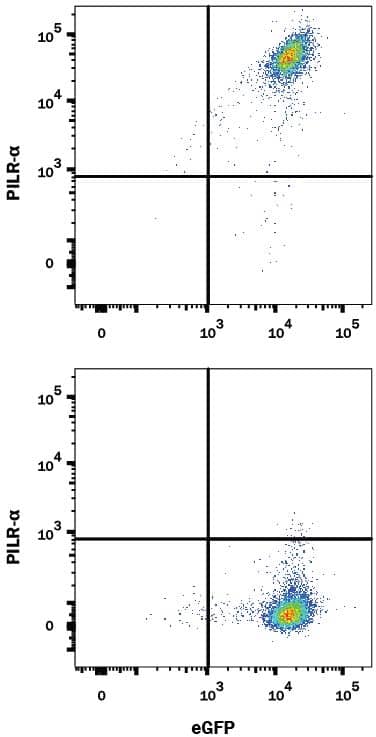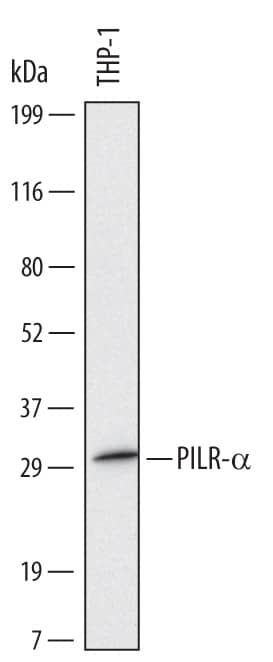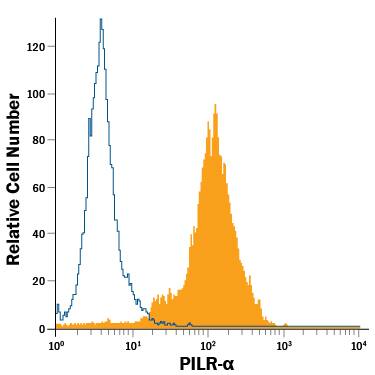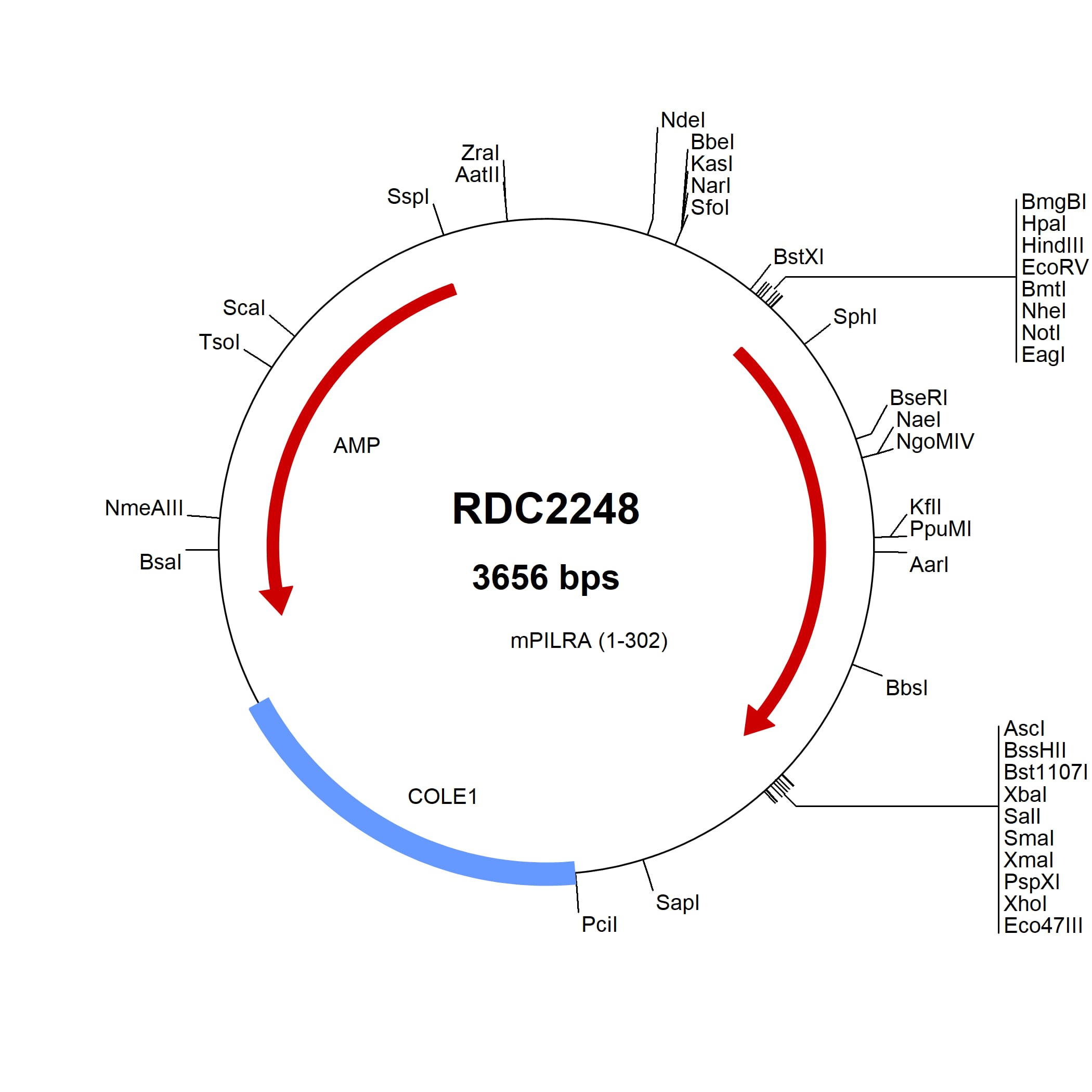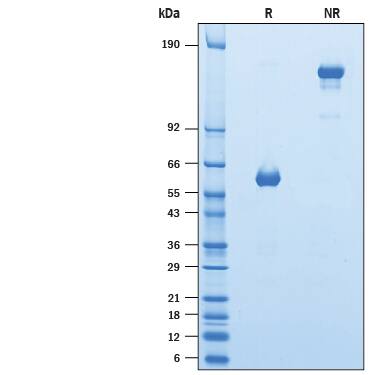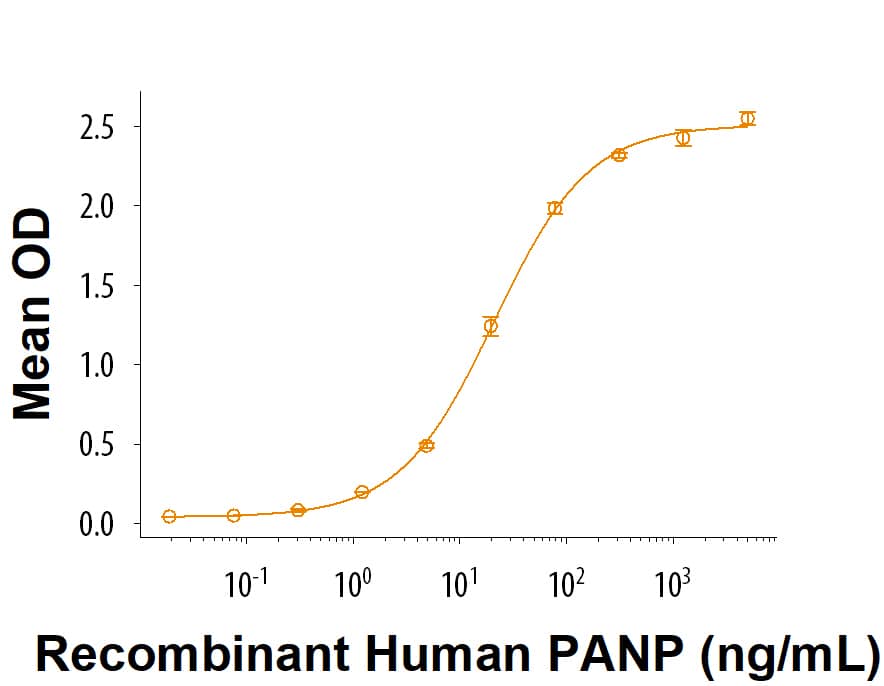PILR-alpha Products
PILR-alpha (paired immunoglobulin-like type 2 receptor-alpha; also named FDF03) is one of two members of a small family of immunoregulatory Ig-superfamily receptors. It is a counterpart to PILR-beta and it likely gave rise to PILR-beta through gene duplication and rearrangement. The PILRs represent one of many pairs of Ig-like domain-containing receptors that participate in immune regulation. PILR-alpha and -beta should not be confused with the similarly named PIRs (also paired immunoglobulin-like receptors), or the functionally-related SIRP and ILT/LILR/CD85/LIR family of receptors. While PIRs, ILTs and SIRPs contain three to six Ig-like domains in their extracellular region, PILR-alpha and -beta show only one Ig-like region in their extracellular domain (ECD). Mouse PILR-alpha is a monomeric, 271 amino acid (aa) type I transmembrane (TM) protein. It contains a 167 aa ECD, a 21 aa TM segment, and a long, 83 aa cytoplasmic region. The ECD shows one V-type Ig-like domain between aa 39-157, while the cytoplasmic region contains two ITIMs (immunoreceptor Tyr-based inhibitory motifs) between aa 265-270 and 294-299. Given that ITIMs are known to interact with phosphatases such as PTPN6 and PTPN11, the presence of these motifs makes mouse PILR-alpha an inhibitory receptor. In human, activation of PILR-alpha inhibits CD32/Fc gamma RII-induced calcium mobilization. Although CD99 is a known ligand for both PILR-alpha and -beta, highest affinity binding seems to occur between CD99 and PILR-alpha. Mouse PILR-alpha is found on neutrophils and macrophages. Mouse PILR-alpha ECD is 43% and 69% aa identical to human and rat PILR-alpha ECD, respectively; it is 75% aa identical to the ECD of mouse PILR-beta. One potential isoform of PILR-alpha has been reported. It varies only within the first 28 aa of the signal sequence.
175 results for "PILR-alpha" in Products
175 results for "PILR-alpha" in Products
PILR-alpha Products
PILR-alpha (paired immunoglobulin-like type 2 receptor-alpha; also named FDF03) is one of two members of a small family of immunoregulatory Ig-superfamily receptors. It is a counterpart to PILR-beta and it likely gave rise to PILR-beta through gene duplication and rearrangement. The PILRs represent one of many pairs of Ig-like domain-containing receptors that participate in immune regulation. PILR-alpha and -beta should not be confused with the similarly named PIRs (also paired immunoglobulin-like receptors), or the functionally-related SIRP and ILT/LILR/CD85/LIR family of receptors. While PIRs, ILTs and SIRPs contain three to six Ig-like domains in their extracellular region, PILR-alpha and -beta show only one Ig-like region in their extracellular domain (ECD). Mouse PILR-alpha is a monomeric, 271 amino acid (aa) type I transmembrane (TM) protein. It contains a 167 aa ECD, a 21 aa TM segment, and a long, 83 aa cytoplasmic region. The ECD shows one V-type Ig-like domain between aa 39-157, while the cytoplasmic region contains two ITIMs (immunoreceptor Tyr-based inhibitory motifs) between aa 265-270 and 294-299. Given that ITIMs are known to interact with phosphatases such as PTPN6 and PTPN11, the presence of these motifs makes mouse PILR-alpha an inhibitory receptor. In human, activation of PILR-alpha inhibits CD32/Fc gamma RII-induced calcium mobilization. Although CD99 is a known ligand for both PILR-alpha and -beta, highest affinity binding seems to occur between CD99 and PILR-alpha. Mouse PILR-alpha is found on neutrophils and macrophages. Mouse PILR-alpha ECD is 43% and 69% aa identical to human and rat PILR-alpha ECD, respectively; it is 75% aa identical to the ECD of mouse PILR-beta. One potential isoform of PILR-alpha has been reported. It varies only within the first 28 aa of the signal sequence.
| Reactivity: | Human |
| Details: | Sheep IgG Polyclonal |
| Applications: | Flow |
His-tag
| Source: | NS0 |
| Accession #: | CAC01613 |
| Applications: | BA |
Recombinant Monoclonal Antibody.
| Reactivity: | Human |
| Details: | Rabbit IgG Monoclonal Clone #2175B |
| Applications: | Flow, Neut |
Recombinant Monoclonal Antibody.
| Reactivity: | Human |
| Details: | Rabbit IgG Monoclonal Clone #2175D |
| Applications: | WB, Flow, IHC |
Recombinant Monoclonal Antibody.
| Reactivity: | Human |
| Details: | Rabbit IgG Monoclonal Clone #2175D |
| Applications: | Flow |
| Reactivity: | Human |
| Details: | Sheep IgG Polyclonal |
| Applications: | Flow, CyTOF-ready |
| Reactivity: | Mouse |
| Details: | Goat IgG Polyclonal |
| Applications: | WB, Flow, CyTOF-ready |
| Reactivity: | Human |
| Details: | Sheep IgG Polyclonal |
| Applications: | Flow |
Recombinant Monoclonal Antibody.
| Reactivity: | Human |
| Details: | Rabbit IgG Monoclonal Clone #2175D |
| Applications: | Flow |
| Reactivity: | Human |
| Details: | Mouse IgG2a Monoclonal Clone #462415 |
| Applications: | WB |
Recombinant Monoclonal Antibody.
| Reactivity: | Human |
| Details: | Rabbit IgG Monoclonal Clone #2175B |
| Applications: | Flow |
| Reactivity: | Mouse |
| Details: | Goat IgG Polyclonal |
| Applications: | WB, Flow, CyTOF-ready |
| Reactivity: | Mouse |
| Details: | Goat IgG Polyclonal |
| Applications: | WB, Flow, CyTOF-ready |
| Reactivity: | Mouse |
| Details: | Goat IgG Polyclonal |
| Applications: | WB, Flow, CyTOF-ready |
| Reactivity: | Mouse |
| Details: | Goat IgG Polyclonal |
| Applications: | WB, Flow, CyTOF-ready |
| Reactivity: | Mouse |
| Details: | Goat IgG Polyclonal |
| Applications: | WB, Flow, CyTOF-ready |
| Reactivity: | Mouse |
| Details: | Goat IgG Polyclonal |
| Applications: | WB, Flow, CyTOF-ready |
| Reactivity: | Mouse |
| Details: | Goat IgG Polyclonal |
| Applications: | WB, Flow, CyTOF-ready |
| Reactivity: | Mouse |
| Details: | Goat IgG Polyclonal |
| Applications: | Flow |
| Source: | CHO |
| Accession #: | Q9UKJ1.3 |
| Applications: | BA |
Biotinylated
| Source: | CHO |
| Accession #: | Q9UKJ1.3 |
| Applications: | BA |
Recombinant Monoclonal Antibody.
| Reactivity: | Human |
| Details: | Rabbit IgG Monoclonal Clone #2175D |
| Applications: | Flow |
Recombinant Monoclonal Antibody.
| Reactivity: | Human |
| Details: | Rabbit IgG Monoclonal Clone #2175D |
| Applications: | Flow |
Recombinant Monoclonal Antibody.
| Reactivity: | Human |
| Details: | Rabbit IgG Monoclonal Clone #2175B |
| Applications: | Flow |

